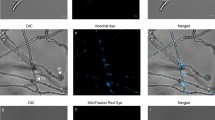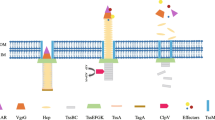Abstract
Autophagy serves as a survival mechanism against starvation and has been reported to be important for cell growth and differentiation in eukaryotes. Here, we investigated the function of a cysteine protease BcAtg4 in the gray mold fungus Botrytis cinerea. Yeast complementation experiments revealed that Bcatg4 can functionally replace the counterpart of yeast. Subcellular localization exhibited that BcAtg4 diffused in cytoplasm at different developmental stages. Targeted gene deletion of Bcatg4 (ΔBcatg4) led to autophagy blocking and a significant retardation in growth and conidiation. In addition, ΔBcatg4 failed to form sclerotia. Infection tests demonstrated that ΔBcatg4 was severely attenuated in virulence on different host plant tissues. All of the phenotypic defects were restored by reintroducing an intact copy of Bcatg4 into ΔBcatg4. These results indicate that Bcatg4 plays multiple roles in the developmental processes and pathogenesis of B. cinerea.






Similar content being viewed by others
References
Bartoszewska M, Kiel JA (2010) The Role of macroautophagy in development of filamentous fungi. Antioxid Redox Sign 14:2271–2287
Boya P, Reggiori F, Codogno P (2013) Emerging regulation and functions of autophagy. Nat Cell Biol 15:713–720
Brandhoff B, Simon A, Dornieden A, Schumacher J (2017) Regulation of conidiation in Botrytis cinerea involves the light-responsive transcriptional regulators BcLTF3 and BcREG1. Curr Genet 5:931–949
Büttner P, Koch F, Voigt K, Quidde T, Risch S, Blaich R, Brückner B, Tudzynski P (1994) Variations in ploidy among isolates of Botrytis cinerea: implications for genetic and molecular analyses. Curr Genet 5:445–450
Dean R, Van Kan JAL, Pretorius A, Hammond-Kosack KE, Di Pietro A, Spanu PD, Rudd JJ, Dickman M, Kahmann R, Ellis J, Foster GD (2012) The top 10 fungal pathogens in molecular plant pathology. Mol Plant Pathol 13:414–430
Deng Y, Ramos-Pamplona M, Naqvi NI (2009) Autophagy-assisted glycogen catabolism regulates asexual differentiation in Magnaporthe oryzae. Autophagy 5:33–43
Deng Y, Qu Z, Naqvi NI (2012) Role of macroautophagy in nutrient homeostasis during fungal development and pathogenesis. Cells 1:449–463
Doehlemann G, Berndt P, Hahn M (2005) Different signalling pathways involving a Gα protein, cAMP and a MAP kinase control germination of Botrytis cinerea conidia. Mol Microbiol 59:821–835
Feng H, Li G, Du S, Yang S, Li X, Figueiredo P, Qin Q (2016) The septin protein Sep4 facilitates host infection by plant fungal pathogens via mediating initiation of infection structure formation. Environ Microbiol 19:1730–1749
Fillinger S, Elad Y (2016) Botrytis—the fungus, the pathogen and its management in agricultural systems. Springer, Switzerland
Geng J, Klionsky DJ (2008) The Atg8 and Atg12 ubiquitin-like conjugation systems in macroautophagy. EMBO Rep 9:859–864
Khan IA, Lu J, Liu X, Rehman A, Lin F (2012) Multifunction of autophagy-related genes in filamentous fungi. Microbiol Res 167:339–345
Kikuma T, Kitamoto K (2011) Analysis of autophagy in Aspergillus oryzae by disruption of Aoatg13, Aoatg4, and Aoatg15 genes. FEMS Microbiol Lett 316:61–69
Kim J, Huang W, Klionsky DJ (2001) Membrane recruitment of Aut7p in the autophagy and cytoplasm to vacuole targeting pathways requires Aut1p, Aut2p, and the autophagy conjugation complex. J Cell Biol 152:51–64
Kirisako T, Ichimura Y, Okada H, Kabeya Y, Mizushima N, Yoshimori T, Ohsumi M, Takao T, Noda T, Ohsumi Y (2000) The reversible modification regulates the membrane-binding state of Apg8/Aut7 essential for autophagy and the cytoplasm to vacuole targeting pathway. J Cell Biol 151:263–275
Klionsky DJ (2005) The molecular machinery of autophagy: unanswered questions. J cell Sci 118:7–18
Klionsky DJ, Emr SD (2000) Autophagy as a regulated pathway of cellular degradation. Science 290:1717–1721
Klionsky DJ, Cregg JM, Dunn WA, Emr SD, Sakai Y, Sandoval IV, Sibirny A, Subramani S, Thumm M, Veenhuis M, Ohsumi Y (2003) A unified nomenclature for yeast autophagy-related genes. Dev Cell 5:539–545
Lai Z, Wang F, Zheng Z, Fan B, Chen Z (2011) A critical role of autophagy in plant resistance to necrotrophic fungal pathogens. Plant J 66:953–968
Levine B, Klionsky DJ (2004) Development by self-digestion: molecular mechanisms and biological functions of autophagy. Dev Cell 6:463–477
Liu X, Lu J, Zhang L, Dong B, Min H, Lin F (2007) Involvement of a Magnaporthe grisea Serine/Threonine kinase gene, MgATG1, in appressorium turgor and pathogenesis. Eukaryot Cell 6:997–1005
Liu T, Liu X, Lu J, Zhang L, Min H, Lin F (2010) The cysteine protease MoAtg4 interacts with MoAtg8 and is required for differentiation and pathogenesis in Magnaporthe oryzae. Autophagy 6:74–85
Lv W, Wang C, Yang N, Que Y, Talbot NJ, Wang Z (2017) Genome-wide functional analysis reveals that autophagy is necessary for growth, sporulation, deoxynivalenol production and virulence in Fusarium graminearum. Sci Rep 7:11062
Mizushima N (2004) Methods for monitoring autophagy. Int J Biochem Cell B 36:2491–2502
Mizushima N, Yoshimori T, Ohsumi Y (2011) The role of Atg proteins in autophagosome formation. Annu Rev Cell Dev Bi 27:107–132
Nair U, Yen W, Mari M, Cao Y, Xie Z, Baba M, Reggiori F, Klionsky DJ (2012) A role for Atg8–PE deconjugation in autophagosome biogenesis. Autophagy 8:780–793
Ohsumi Y (2001) Molecular dissection of autophagy: two ubiquitin-like systems. Nat Rev Mol Cell Bio 2:211–216
Pollack JK, Harris SD, Marten MR (2009) Autophagy in filamentous fungi. Fungal Genet Biol 46:1–8
Ren W, Zhang Z, Shao W, Yang Y, Zhou M, Chen C (2017) The autophagy-related gene BcATG1 is involved in fungal development and pathogenesis in Botrytis cinerea. Mol Plant Pathol 18:238–248
Ren W, Liu N, Sang C, Shi D, Zhou M, Chen C, Qin Q, Chen W (2018a) The autophagy gene BcATG8 regulates the vegetative differentiation and pathogenicity of Botrytis cinerea. Appl Environ Microb 84:e02455–e02417
Ren W, Sang C, Shi D, Song X, Zhou M, Chen C (2018b) Ubiquitin-like activating enzymes BcAtg3 and BcAtg7 participate in development and pathogenesis of Botrytis cinerea. Curr Genet. https://doi.org/10.1007/s00294-018-0810-3
Schiestl RH, Gietz RD (1989) High efficiency transformation of intact yeast cells using single stranded nucleic acids as a carrier. Curr Genet 16:339–346
Schumacher J (2012) Tools for Botrytis cinerea: new expression vectors make the gray mold fungus more accessible to cell biology approaches. Fungal Genet Biol 49:483–497
Shoji J, Arioka M, Kitamoto K (2006) Possible involvement of pleiomorphic vacuolar networks in nutrient recycling in filamentous fungi. Autophagy 2:226–227
Van Kan JAL, Stassen JHM, Mosbach A, Van Der Lee TAJ, Faino L, Farmer AD, Papasotiriou DG, Zhou S, Seidl MF, Cottam E, Edel D, Hahn M, Schwartz DC, Dietrich RA, Widdison S, Scalliet G (2016) A gapless genome sequence of the fungus Botrytis cinerea. Mol Plant Pathol 1:75–89
Voigt O, Pöggeler S (2013) Autophagy genes Smatg8 and Smatg4 are required for fruiting-body development, vegetative growth and ascospore germination in the filamentous ascomycete Sordaria macrospora. Autophagy 9:33–49
Wang C, Klionsky DJ (2003) The molecular mechanism of autophagy. Mol Med 9:65–76
Wen X, Klionsky DJ (2016) An overview of macroautophagy in yeast. J Mol Biol 428:1681–1699
Williamson B, Tudzynski B, Tudzynski P, Van Kan JAL (2007) Botrytis cinerea: the cause of grey mould disease. Mol Plant Pathol 8:561–580
Xie Z, Klionsky DJ (2007) Autophagosome formation: core machinery and adaptations. Nat Cell Biol 9:1102–1109
Yorimitsu T, Klionsky DJ (2005) Autophagy: molecular machinery for self-eating. Cell Death differ 2:1542–1552
Yu F, Gu Q, Yun Y, Yin Y, Xu J, Shim WB, Ma Z (2014) The TOR signaling pathway regulates vegetative development and virulence in Fusarium graminearum. New Phytol 203:219–232
Acknowledgements
This work was supported by the National Science Foundation of China (31672065 and 31801778), China Agriculture Research System (CARS-24-C-01) and Jiangsu Provincial Agricultural Plans [PZCZ201715 and CX(18)2005].
Author information
Authors and Affiliations
Corresponding authors
Additional information
Communicated by M. Kupiec.
Electronic supplementary material
Below is the link to the electronic supplementary material.
Fig. S1
Generation and identification of Bcatg4 deletion mutant. a Gene replacement strategy of Bcatg4. b Southern blot analysis of Bcatg4 deletion mutant (TIF 1063 KB)
Rights and permissions
About this article
Cite this article
Liu, N., Ren, W., Li, F. et al. Involvement of the cysteine protease BcAtg4 in development and virulence of Botrytis cinerea. Curr Genet 65, 293–300 (2019). https://doi.org/10.1007/s00294-018-0882-0
Received:
Revised:
Accepted:
Published:
Issue Date:
DOI: https://doi.org/10.1007/s00294-018-0882-0




